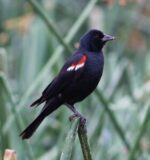
Status: California Endangered Species1
- Has declined seriously in numbers in recent decades
- loss of habitat contributes to their status
- Its habit of nesting in dense colonies probably makes it more vulnerable
Habitat:
- Cattail or tule marshes
Feeding Behavior/Diet:
- Fodders mostly while walking on ground, but also in shrubs and trees. Hunts in flocks, particularly outside the breeding season
- Does most of its foraging in open habitats such as farm fields, pastures, cattle pens, large lawns.
- Feeds on many insects, especially in summer, including caterpillars, beetles, grasshoppers, and spiders. In fall and winter, eats many seeds of grasses and weeds, and waste grain
Reproduction:
- Breeds in large freshwater marshes, in dense stands of cattails or bulrushes
- Nests in colonies
- 3-5 eggs
- Incubation is by female, about 11 days
- Young leave the nest about 11-14 days after hatching.
1HELIX Environmental Planning Carson Creek Preserve Long Term Management Plan Rev 6/15/2021
2 Information provided by National Audubon Society. https://audubon.org
